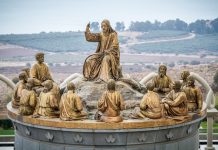
by Alice Pfeifer, CSA
This Complete-A-Project Bible Search Activity is for teacher and students (grades 4-6) working together. The exercise can be completed using the Bible to find the answers to fill in the blanks on the Activity Sheet [CLICK HERE]. Bible Searches for this learning year focus on Gospels from the current liturgical year and feature real-life scenarios in which names and other details have been slightly modified.
Background
* March 20 is the Second Sunday of Lent this year. The Gospel is about the Transfiguration of Jesus (Matthew 17:1-9). The Transfiguration happened soon after Jesus upset his disciples by predicting his coming passion and death.
* At first, everything that happens on the mountain is wonderful for everyone. The Apostles have never seen Jesus transfigured before—that is, so permeated with light that he becomes a being of light. But the Apostles know from Scripture that such things are possible. For the Jews, light was always a sign of God’s presence. Moses heard God speak from a burning bush. In the form of a pillar of fire by night, God led the Chosen People out of Egypt. Sometimes the face of Moses glowed after spending time alone with God.
* Seeing Moses and Elijah with Jesus is a great sign for the three Apostles. Moses represents the Law, and Elijah represents the prophets. The presence of these two heroes of the Jewish faith confirm for the Apostles that Jesus is God’s anointed Messiah.
* It is with high spirits, too, that Peter offers to build tents for Jesus, Moses, and Elijah. Some scholars think that he wanted to duplicate on the mountain the Jewish Feast of Tabernacles, which involved living outdoors in tents for a number of days. This was done to remember the time when God’s people were tent dwellers while journeying through the wilderness to the Promised Land.
* The Apostles’ mood shifts to fear when a bright cloud overshadows them and a divine voice announces that Jesus is God’s own dear Son. They fall prostrate to the ground, most likely thinking they are about to be struck dead, for the Jews believed no one could see God and live. But why are they so afraid? Hadn’t God clearly called Jesus his Son at his baptism, too? Actually, translators of the original Greek say that only Jesus hears God’s voice at his baptism, for it is barely a whisper. At the Transfiguration, God’s voice is so loud and clear that Jesus and his companions hear it.
* The only thing that restores the Apostles’ calm is the touch of Jesus’ hand on their shoulders. Only later do they understand why they shouldn’t “tell the vision to anyone.” They had been given a preview of Easter glory.
MATERIALS
* Activity sheet [CLICK HERE], one for each student
* Bibles (The Search is based on the New American Bible.)
* Pencils or pens
PROCEDURE
1. Ask students what they must do to listen closely to their teachers. How is listening to God the same or different from listening to teachers? Write on a chalkboard the words same and different, and record the children’s ideas.
2. Note that today’s story is about a mother who obeys God and listens to God’s Son during a really hard time in her life. Read or have volunteers read the set-up to the fill-in-the-blank activity.
3. Question the group about the story’s beginning: From clues given in the story, how old would you say André was when he died? Does anything about Rosa surprise you? There are many ways to pray. You can talk in your own words or borrow someone else’s words. You can speak silently in your heart, whisper, talk aloud, shout, or even sing your prayers. How does Rosa pray during Mass? Rosa hears a homily about the Transfiguration. What do you know about this event in the life of Christ?
4. Work together to fill in the blanks for Matthew 17:1-9. Make sure children know the meanings of any unfamiliar words.
5. Share the information about the Transfiguration from Background.
6. Observe that the three Apostles go from joy to fear to relief. Ask the group to note how Rosa’s mood changes as you read together the conclusion to her story.
7. Help the children see that Jesus’ usual way of speaking to us is through ordinary everyday experiences. For example, Jesus speaks through anyone in our daily lives whose words come from a place of wisdom and kindness. But, like Rosa, we often don’t recognize Jesus’ voice in other people until we listen to Jesus’ voice in the celebration of the Sacraments (especially the Eucharist) and in Sacred Scripture. It takes patience and a listening heart to hear Jesus speak. Rosa heard Jesus because she had these qualities.
Answers to Fill-ins: Peter, high, transfigured, face, clothes, Moses, Elijah, Lord, tents, you, cloud, voice, Son, listen to him, prostrate, afraid, touched, Rise, disciples, Jesus, vision, Son of Man
—Guide and activity page by Alice Pfeifer, CSA.
Copyright 2011, Bayard, Inc. All rights reserved. This article is protected by United States copyright and other intellectual property laws and may not be reproduced, rewritten, distributed, redisseminated, transmitted, displayed, published or broadcast, directly or indirectly, in any medium without the prior written permission of Bayard, Inc.
This article was written by the Catechist Staff and appeared in Catechist magazine, February 2011.
Image Credit: Shutter Stock 6709591




